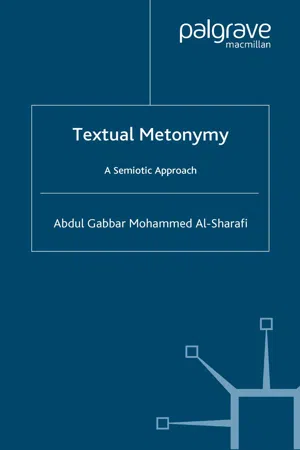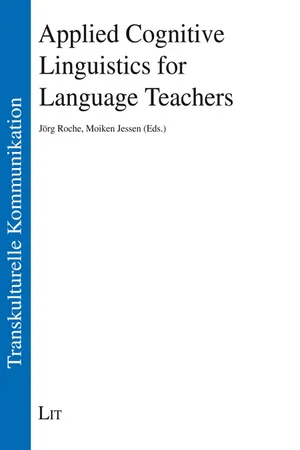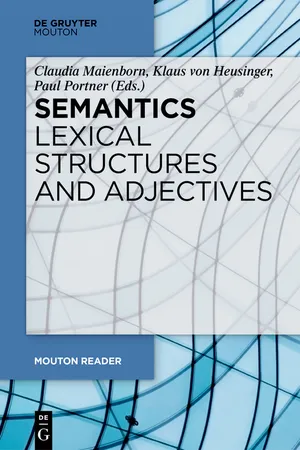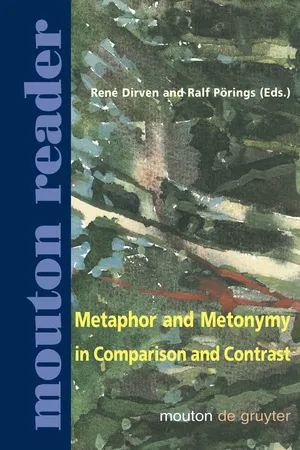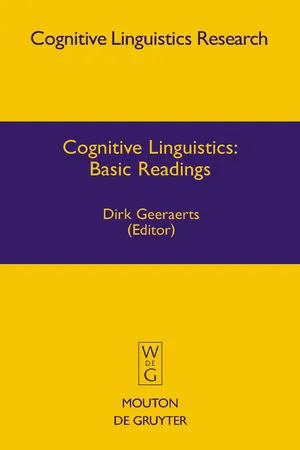Languages & Linguistics
Metonymy
Metonymy is a figure of speech where one word is substituted for another with which it is closely associated. This association can be based on contiguity, similarity, or cause and effect. For example, using "the White House" to refer to the U.S. government or "the crown" to refer to a monarch are instances of metonymy.
Written by Perlego with AI-assistance
11 Key excerpts on "Metonymy"
- eBook - PDF
Textual Metonymy
A Semiotic Approach
- A. Al-Sharafi(Author)
- 2004(Publication Date)
- Palgrave Macmillan(Publisher)
In Metonymy, how- ever, it is difficult to establish such a coherent metalanguage for the simple reason that these metalinguistic terms are actually non-existent in the process of metonymic signification. Although it is true that we can account for metonymic relations by means of terminology like ‘trigger’ and ‘target’, the feature that characterises Metonymy is that the connector that links the two terms is not based on one relation as is the case with metaphor. Rather, it is based on a multiplicity of relations. Therefore, it is essential to account for Metonymy by means of a typology of metonymic relations or meto- nymic concepts, rather than formulas as in the case of metaphor. The list of metonymic relations provided by linguists and cognitivists, which is calcu- lated at 46 by Radden and Kövecses (1999), is a good example of how diverse and heterogeneous the concept of contiguity is. One can still argue however that even if contiguity has diverse manifesta- tions, this does not necessarily mean that the interpretation of Metonymy is problematic, as Jakobson argues. The problem, probably, lies in the linguis- tic or more precisely the formal approach Jakobson is imposing on the inter- pretation of tropes. I think that had Jakobson approached the issue with a cognitive orientation, his conclusion would have been different. The reason is that cognitively speaking Metonymy is in fact much easier to interpret than metaphor because the signification of Metonymy, unlike metaphor, 38 Textual Metonymy does not involve a transfer between different domains, which normally involves more effort in message comprehension and processing. Rather, the substitution takes place between different aspects or elements of the same domain. This feature should make interpretation easy rather than difficult. It should be easier to understand Metonymy because one does not need to make a conceptual shift between domains but shifts within the same domain. - eBook - ePub
Semiotics and City Poetics
Jakobson’s Theory and Praxis
- Mary Coghill(Author)
- 2022(Publication Date)
- De Gruyter Mouton(Publisher)
Chapter 3 Roman Jakobson and Metonymy: Linguistics and semiotics This is the first of two chapters dedicated to the study of Metonymy. In this chapter the emphasis is on the origins of the term and whether linguistics can provide a full interpretation of it. Jakobson’s Formalist definition of the term provides further complexity – or indeed, perhaps, simplicity. Metonymy, especially in poetry, is one of the lesser studied tropes. This is a trope which functions through substitution. The roles of Metonymy in both poetry and prose are explored. The other three major tropes are metaphor, synecdoche and irony (NPEPP. 1993. 1261a). Tropes can also be classified as having various more specific characteristics. Following Jakobson, others state that there are only two tropes – metaphor and Metonymy, where synecdoche is an aspect of Metonymy (NPEPP. 1993.1261a). What is a trope? It was used originally to describe certain forms of cadence or embellishment in church music. More generally, within literary criticism, it is: “a figure of speech which consists in the use of a word or phrase in a sense other than that which is proper to it; also, in casual use, a figure of speech; figurative language” (OED 1968: 2252c). With regard to poetry, does Metonymy form an appropriate poetic trope? Jakobson himself ascribed it to prose rather than to poetry. It is, however, hard to find a clear definition of Metonymy. The word is from the Greek and means “change of name”. It is, as stated in the NPEPP : “A figure in which one word is substituted for another on the basis of some material, causal, or conceptual relation” (1993: 783b). The fundamental characteristic of the metonym is that of substitution. “A proper term is substituted for another for the sake of ornament” (Cicero: “De Oratore 3.42”.167/8) - eBook - PDF
Cognitive Linguistics
Current Applications and Future Perspectives
- Gitte Kristiansen, Michel Achard, René Dirven, Francisco J. Ruiz de Mendoza Ibáñez, Gitte Kristiansen, Michel Achard, René Dirven, Francisco J. Ruiz de Mendoza Ibáñez(Authors)
- 2008(Publication Date)
- De Gruyter Mouton(Publisher)
Metonymy as a usage event 147 Metonymy as a usage event 1 Klaus-Uwe Panther Abstract In this chapter a view of Metonymy as an indexical relation between source and target meaning is presented and contrasted with metaphor, which is regarded as a specific kind of iconic relation. It is shown that notions such as ‘domain’, ‘subdo-main’, ‘single domain’, and ‘separate domains’, which have often been used as definitional criteria for distinguishing Metonymy from metaphor, are unreliable because they are cover terms for heterogeneous concepts and conceptual relations. Furthermore, it is argued that Metonymy is a kind of meaning elaboration whose result is a conceptually prominent target meaning, an integrated whole that con-tains the backgrounded source meaning and novel meaning components resulting from the process of elaboration. Finally, the role of context in the interpretation of Metonymy in usage events is explored in two case studies. A detailed analysis of two contextualized metonymically used expressions, suggests that one important function of Metonymy is to provide generic prompts. These serve as inputs for ad-ditional pragmatic inferences that flesh out the specifics of the intended utterance meaning. Keywords: conceptual prominence, domain, generic prompt, iconic relation, in-dexical relation, meaning elaboration, pragmatic inference 1. Introduction The last two decades have seen a remarkable renewed interest in figures of speech, in particular, metaphor and Metonymy. The interpretation of metaphor and Metonymy has been a major concern in psycholinguistics, pragmatics, and, of course, cognitive linguistics (see Gibbs 1994). In cog-nitive linguistics the focus of analysis has shifted from the stylistic and embellishing function of metaphor and Metonymy in discourse to their role in human thinking and reasoning, and their impact on language structure and language use. The study of language use is of common in-terest to both pragmatics and cognitive linguistics. - eBook - ePub
Metonymy and Language
A New Theory of Linguistic Processing
- Charles Denroche(Author)
- 2014(Publication Date)
- Taylor & Francis(Publisher)
Taxonomies can also distract us from questions of more consequence, such as attempting to understand the mechanism and motivation behind Metonymy—the main concern of this work. For the present study, the problem is not so much classifying metonymies into types but making a distinction between conventional and novel use. Most of the discussions in the literature concern ready-made signs, that is, words, compounds or phrases which are already part of the corpus of a language. While these are certainly of great interest in revealing metonymic processes which have occurred in the past, they tell us little about the mental process in communication. As Gibbs observes, “People may […] comprehend conventional metonymic language without necessarily drawing metonymic mappings” (Gibbs 1999:74). A similar observation was made regarding metaphor in Chapter 3, which led to identifying Metonymy as the mechanism behind active metaphorization. Conclusion This chapter has developed a General Theory of Metonymy. I have shown that the ability to recognize relatedness has a wide reach, playing an important role in conceptualization, in the language system and in face-to-face interaction using language. Metonymy is important in defining categories, in pragmatic inferencing and in realizing literal and metaphoric meaning, as well as metonymic meaning. I have developed a more precise ontology of Metonymy in this chapter by exploring domain theory, the metaphor-Metonymy continuum and typologies of Metonymy. In the next chapter, I look at the role played by the active use of metonymic mapping in communication and the strikingly conspicuous role Metonymy plays in various cultural and social activities, which seem to have no purpose other than to fulfil a ludic or recreational function, a sense of play and enjoyment in Metonymy for its own sake. - Jorg Roche, Moiken Jessen(Authors)
- 2023(Publication Date)
- LIT Verlag(Publisher)
- Traditional linguistics views Metonymy as a transfer of denota- tions from one denotatum to another based on contiguity. - Metaphor and Metonymy have the effect that the range of mean- ings of the transferred words is expanded. It makes them polyse- mous. - All the important functions of metaphor and Metonymy were for- merly attributed to a necessity of finding new designations for new denotata. - Metaphor and Metonymy are systemic and regular linguistic phe- nomena. Many are no longer perceived as imagery-based or trans- ferred denotations. They are lexicalized and conventionalized. - Cognitive linguistics’ understanding of metaphor has changed. Metaphor is now viewed as a cognitive mechanism of conceptual- ization, a result of cross-domain mappings. Physical (embodied) experiences and structures based on experiences serve as source domains for the conceptualization of abstract target domains. - The culture of the language community plays an important role. It can lead to differences between the languages in terms of the se- mantic structures of polysemous words and idiomatic expressions. - Not only linguistic knowledge is necessary to understand meta- phors: encyclopaedic knowledge (culture, history, traditions) is also required. 3.1.4 Review Questions 1. How has the understanding of imagery-based language changed over time? 2. Explain how the metaphoric transfer of denotations takes place. Use examples to illustrate the processes. 3. How can the differences of metaphoric meanings between lan- guages be explained? Illustrate using examples. 111 4. Explain how the metonymic transfer of denotations takes place. Illustrate using examples. 5. Explain how the understanding of the metaphor as a cognitive mechanism of conceptualization differs from the understanding of the metaphor as a purely linguistic phenomenon. 6. How do you explain the differences in metaphoric conceptualizing between various languages?- eBook - PDF
Cognitive Linguistics
Internal Dynamics and Interdisciplinary Interaction
- M. Sandra Peña Cervel, Francisco J. Ruiz de Mendoza Ibáñez, M. Sandra Peña Cervel, Francisco J. Ruiz de Mendoza Ibáñez(Authors)
- 2008(Publication Date)
- De Gruyter Mouton(Publisher)
The research in Barcelona (2000), Dirven and Pörings (2002), Lakoff (1987), Langacker (2000), Panther and Radden (1999), Panther and Thornburg (2003), and Radden and Kövecses (1999) has shown that Metonymy is better understood as a “reference point” (a vehicle or source) that triggers a target meaning. Francisco Ruiz de Men-doza and his collaborators at the University of La Rioja regard Metonymy as a process that involves either the expansion or reduction of a cognitive domain (matrix) (see e.g. Ruiz de Mendoza and Pérez 2003; Ruiz de Men-doza and Díez 2004). This body of research emphasizes the conceptual nature of Metonymy and is indeed an important step forward from the sim-plistic view of Metonymy as a mere rhetorical trope to the insight that me-tonymy is a ubiquitous mental operation. The basic metonymic relation that I propose can be diagrammed as in Figure 2: 358 Klaus-Uwe Panther Figure 2 . The basic metonymic relation In a linguistically manifest metonymic relation, a source meaning is re-lated to a target meaning by means of a linguistic form (e.g. morpheme, word, phrase, sentence) that I call the linguistic vehicle . 8 The larger ellipse in Figure 2 represents the generally accepted assumption that the me-tonymic mapping takes place within one cognitive domain or Idealized Cognitive Model (ICM). Figure 2 also indicates that the source meaning is not obliterated by the target meaning, but still conceptually present (“sali-ent”) or activated. It also represents the idea that the target meaning is an elaboration of the source meaning, with the source meaning being one con-ceptual component of the target meaning (see below). Figure 2 does not indicate how stable or conventional the target meaning is. Indeed, the tar-get meaning can be just a nonce sense, created on the spot, but it can also, through frequency of use, become a conventionalized meaning, stored separately in the mental lexicon. - Claudia Maienborn, Klaus von Heusinger, Paul Portner(Authors)
- 2019(Publication Date)
- De Gruyter Mouton(Publisher)
https://doi.org/10.1515/9783110626391-011 Andrea Tyler and Hiroshi Takahashi 11 Metaphors and metonymies 1 Introduction 350 2 Traditional approaches to metaphor 353 3 Pragmatic accounts of metaphor 354 4 Psycholinguistic approaches to figurative language 361 5 Cognitive and conceptual accounts 363 6 Metonymy 373 7 References 376 Abstract: For centuries, the study of metaphor and Metonymy was primarily the province of rhetoricians. Although scholars developed a number of variations on the theme, the prevailing perspectives, i.e. that these tropes are stylistic devices used primarily for literary purposes and result from some kind of transfer of meaning between similar entities, remained largely unchanged from Aristotle until the mid twentieth century. Aspects of this long tradition still exist in current accounts that continue to argue that metaphoric meaning is in some way deviant, involves trans-ference, and should be analyzed on a word by word basis. In the last 50 years lin-guists, such as Lakoff and Sperber & Wilson, have joined philosophers, such as Black and Grice, in the debate. The result has been a sharp increase in interest in non-literal language and a number of major innovations in metaphor theory. Met-aphor and Metonymy are now understood to be ubiquitous aspects of language, not simply fringe elements. The study of metaphor and Metonymy have provided a major source of evidence for Cognitive Linguists to argue against the position that a sharp divide exists between semantics and pragmatics. Mounting empirical data from psychology, especially work by Gibbs, has led many to question the sharp boundary between literal and metaphorical meaning. While distinct perspectives remain among contemporary metaphor theorists, very recent developments in rel-evance theory and cognitive semantics also show intriguing areas of convergence. 1 Introduction It is an exaggeration to say that metaphor and Metonymy are the tropes that launched 1,000 theories.- eBook - PDF
- Antonio Barcelona(Author)
- 2012(Publication Date)
- De Gruyter Mouton(Publisher)
Metonymy is more related to this second type of metaphor. Second, we shall contend that métonymie mappings may be of two types: one, in which the source is a subdomain of the target (source-in-target metonymies); another in which the target is a sub-domain of the source (target-in-source metonymies). We therefore exclude, for interpretation purposes, the traditional idea of mappings where a subdomain stands for another subdomain within the same domain. We shall give evidence for the relevance of this distinction between two Metonymy types by examining correlations - where Metonymy plays an important role - between each of them and cases of anaphoric reference in relation to the conjoining of predicates, on the one hand, and cases of conceptual interaction involving metaphor and me- 110 Francisco José Ruiz de Mendoza Ibáñez tonymy, on the other hand. Third, we have the question - raised by Croft (1993) — of the role of the primary or secondary nature of the domains which take part in Metonymy. Our conclusions here, in combination with the insights gained from the previous discussion, will allow us to spell out a full definition of Metonymy which will take into consideration (i) the nature of the mappings, (ii) the type of relation between the domains involved, (iii) the nature of the domains in terms of centrality. 2. Metaphoric mappings A metaphor has been defined as a set of correspondences (or conceptual map-pings) between two conceptual domains where one of the domains (called the source) helps us to structure, understand and reason about the other (called the target) (see Lakoff, 1993: 206-207). One essential feature of metaphorical con-cepts is their systematicity. Consider Lakoff and Johnson's account of the metaphors ARGUMENT IS WAR and TIME IS MONEY (Lakoff - Johnson, 1980: 4-9). - eBook - PDF
Metaphor, Metonymy, and Experientialist Philosophy
Challenging Cognitive Semantics
- Verena Haser(Author)
- 2011(Publication Date)
- De Gruyter Mouton(Publisher)
The merits of their theory can best be assessed in relation to frame-based accounts of Metonymy. Hence, their suggestions will be discussed only after we have scrutinized these approaches. 22 Metaphor and Metonymy in cognitive linguistics 2.2.4 Contiguity If the notion of similarity is fraught with difficulties, so is the concept of contiguity, and hence Metonymy. Most cognitive linguists subscribe to the familiar definition of Metonymy in terms of contiguity: 'Metonymy' is a semantic link between two senses of a lexical item that is based on a rela-tionship of contiguity between the referents of the expression in each of those senses (Geeraerts 1994: 2477). However, they part company over how to specify the notion of contiguity, which seems to have been intro-duced by Roudet (1921) (cf. Blank 1999: 171). What types of contiguity should be distinguished? How to elucidate the notion in non-metaphorical terms, i.e., what precisely is contiguity, or experiential 'togetherness' (Waltereit 1999: 234)? Should the concept be extended to implicatures? There is no consensus on how to answer such questions, even though in recent years something like a received view has emerged. Many linguists emphasize the omnipresence of Metonymy in ordinary language and reject the assumption that Metonymy essentially serves as a poetic embellish-ment (cf. Lakoff/Turner 1989; Gibbs 1994; Feyaerts 1999). Psychological studies lend support to the assumption that Metonymy is typically based on firmly established associations between entities. Gibbs (1993: 259) approvingly cites a principle originally advanced by Turner (1987), which restricts the use of Metonymy to particular types of contigu-ity relations: A thing may stand for what it is conventionally associated with. For instance, names of famous composers are often used metonymi-cally to refer to their works (e.g., He loves Mozart). - René Dirven, Ralf Pörings, René Dirven, Ralf Pörings(Authors)
- 2009(Publication Date)
- De Gruyter Mouton(Publisher)
408 Günter Rodden 1. Introduction The distinction between the notions of metaphor and Metonymy is notoriously difficult. In cognitive linguistics, metaphor is usually defined as a mapping across two conceptual domains, while meton-ymy is defined as a mapping within a single conceptual domain (see e.g. Lakoff & Turner 1989: 103). The notion of conceptual domain is thus crucial to defining metaphor and Metonymy as well as distin-guishing one from the other. In Langacker's (1991: 547) definition, a conceptual domain is [a]ny coherent area of conceptualization rela-tive to which semantic structures can be characterized (including any kind of experience, concept or knowledge system). Conceptualisa-tions as well as one's experiences, concepts and knowledge systems are necessarily subjective and may thus differ from person to person although there is, of course, a large amount of intersubjective agree-ment on our experiences. We need to be aware of the possibility, however, that people's characterisations of semantic structures in-cluding figurative language may be different. This of course also applies to characterisations of language by linguists. For example, in pointing out the experiential basis of metaphor, Lakoff (1993: 240). discusses, amongst other metaphors, MORE IS UP and states that the MORE IS UP metaphor is grounded in experience -in the common experiences of pouring more fluid into a container and seeing the level go up, or adding more things to a pile and seeing the pile get higher. Taylor (*341, 1995: 138) takes up this issue and argues that height is literally correlated with quantity and that this natural association between quantity and vertical extent is one of Metonymy. It is only when more abstract instances of addition are involved that metaphor takes over as, for example, when one speaks of high prices.- eBook - PDF
- Dirk Geeraerts(Author)
- 2008(Publication Date)
- De Gruyter Mouton(Publisher)
5 They are part of another metaphor, which can generate metaphorical expressions using words profiled in the domain of living things: (14) Their letters kept their love alive. (15) Her selfishness killed the relationship. (16) His effort to understand her breathed new life into their marriage . Of course, and are metaphors coherent with each other, since bodily states presuppose the notion of life. However, the meta-phors cannot be lumped together under something like “love is a living thing”, since there are many other aspects of living things that are not metaphors for love, specifically those associated with the body (bodily activities, such as spitting, sweating; or the body itself, e.g. its parts; etc.). The role of domains in metaphor is quite central to the definition of that con-cept in Lakoff and Johnson’s model. However, to be more precise about the phe-nomenon that I am examining, I will use the term domain mapping to describe metaphor (though since in the Lakoff-Johnson model, the two terms are virtually synonymous, I will continue to use the term “metaphor”). The role of domains in Metonymy, on the other hand, is not direct, although it is more pervasive than 280 William Croft has generally been noted, once a careful examination of the domain structure underlying a concept is undertaken. The traditional definition of Metonymy is a shift of a word-meaning from the entity it stands for to a “contiguous” entity (Ullmann 1957: 232; cf. Lakoff and Johnson 1980: 35 and Taylor 1989: 122). Entities are contiguous because they are associated in experience (Lakoff and Johnson 1980: 39–40). Lakoff and Turner argue that Metonymy, unlike metaphor, “involves only one conceptual domain. A metonymic mapping occurs within a single domain, not across domains” (Lakoff and Turner 1989: 103). However, as we have seen above, a concept is profiled against an often very complex domain structure or matrix, even if there is only one abstract domain as the base.
Index pages curate the most relevant extracts from our library of academic textbooks. They’ve been created using an in-house natural language model (NLM), each adding context and meaning to key research topics.
